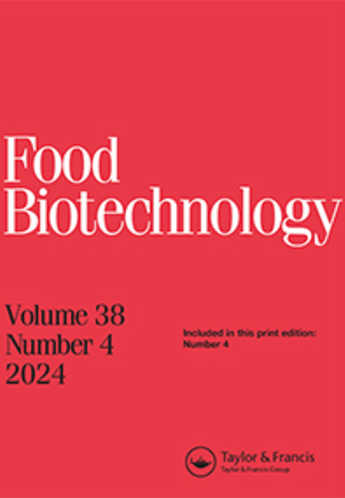Isothermal amplification assay for visual on-site detection of Staphylococcus aureus in Chevon
IF 1.6
4区 农林科学
Q4 BIOTECHNOLOGY & APPLIED MICROBIOLOGY
引用次数: 3
Abstract
ABSTRACT The ability to rapidly detect pathogens in food is important from public health and food safety reasons. Traditional culture-based detection methods tend to be laborious, time consuming, technically demanding and may be limited due to their low sensitivity. Rapid detection methods for foodborne pathogens should be specific and sensitive to detect pathogens in low numbers. Sensitivity is important because a single pathogen present in food has the potential risk to cause infection. PCR and Real-time PCR are rapid, sensitive, and specific but require specific instruments and laboratory set-up. In the present study, a simple loop-mediated isothermal amplification (LAMP) assay was developed for rapid detection of Staphylococcus aureus. The LAMP assay was found to be ten times more sensitive than traditional end-point PCR with analytical sensitivity of 0.56 pg/μl and 5.6 pg/μl of DNA, respectively. In spiked chevon samples inoculated with S. aureus, the detection limit of LAMP and PCR assay was 3.3 × 105 CFU/g and 3.3 × 106 CFU/g, respectively, without enrichment. After enriching the samples for 6 h, the detection limit improved to 3.3 × 102 CFU/g and 3.3 × 104 CFU/g, respectively, indicating LAMP to be 100-fold more sensitive than PCR. The detection limit further improved to 3.3 CFU/g of meat after enrichment of 12 h. The developed LAMP was also found to be suitable when evaluated on field samples. The present study reports a simple LAMP assay for rapid visual detection of S. aureus which has potential for use in resource limited settings.等温扩增法现场目测金黄色葡萄球菌
从公共卫生和食品安全的角度来看,快速检测食品中病原体的能力非常重要。传统的基于培养的检测方法往往费力、耗时、技术要求高,并且可能由于灵敏度低而受到限制。食源性致病菌快速检测方法应具有特异性和敏感性,以检测少量致病菌。敏感性很重要,因为食物中存在的单一病原体有引起感染的潜在风险。聚合酶链反应和实时聚合酶链反应是快速,敏感和特异性,但需要特定的仪器和实验室设置。本研究建立了一种简单的环介导等温扩增(LAMP)方法,用于快速检测金黄色葡萄球菌。LAMP法的灵敏度是传统终点PCR的10倍,分析灵敏度分别为0.56 pg/μl和5.6 pg/μl。在金黄色葡萄球菌接种的加标样品中,LAMP法和PCR法的检出限分别为3.3 × 105 CFU/g和3.3 × 106 CFU/g,无富集。样品富集6 h后,检出限分别提高到3.3 × 102 CFU/g和3.3 × 104 CFU/g,表明LAMP比PCR灵敏度提高100倍。富集12 h后,LAMP的检出限进一步提高到3.3 CFU/g。对现场样品进行了评价,发现LAMP是合适的。本研究报告了一种简单的LAMP测定法,用于快速目视检测金黄色葡萄球菌,在资源有限的环境中有可能使用。
本文章由计算机程序翻译,如有差异,请以英文原文为准。
求助全文
约1分钟内获得全文
求助全文
来源期刊

Food Biotechnology
工程技术-生物工程与应用微生物
CiteScore
3.80
自引率
0.00%
发文量
15
审稿时长
>12 weeks
期刊介绍:
Food Biotechnology is an international, peer-reviewed journal that is focused on current and emerging developments and applications of modern genetics, enzymatic, metabolic and systems-based biochemical processes in food and food-related biological systems. The goal is to help produce and improve foods, food ingredients, and functional foods at the processing stage and beyond agricultural production.
Other areas of strong interest are microbial and fermentation-based metabolic processing to improve foods, food microbiomes for health, metabolic basis for food ingredients with health benefits, molecular and metabolic approaches to functional foods, and biochemical processes for food waste remediation. In addition, articles addressing the topics of modern molecular, metabolic and biochemical approaches to improving food safety and quality are also published.
Researchers in agriculture, food science and nutrition, including food and biotechnology consultants around the world will benefit from the research published in Food Biotechnology. The published research and reviews can be utilized to further educational and research programs and may also be applied to food quality and value added processing challenges, which are continuously evolving and expanding based upon the peer reviewed research conducted and published in the journal.
 求助内容:
求助内容: 应助结果提醒方式:
应助结果提醒方式:


